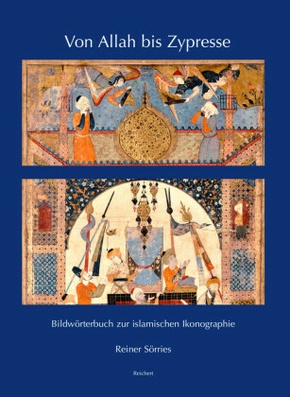
Von Allah bis Zypresse - Bildwörterbuch zur islamischen Ikonographie
| Verlag | Reichert |
| Auflage | 2021 |
| Seiten | 264 |
| Format | 21,2 x 2,1 x 30,0 cm |
| Gewicht | 1177 g |
| ISBN-10 | 3954904470 |
| ISBN-13 | 9783954904471 |
| Bestell-Nr | 95490447A |
Dem vermeintlichen mohammedanischen Bilderverbot steht eine vielfältige islamische Bilderwelt entgegen, die religiöse und profane Szenen ebenso kennt wie mythologische und symbolische Motive. Sie werden hier erstmals systematisch und für alle Kunstgattungen erschlossen. Der lexikalische Teil von A bis Z wird ergänzt durch Erläuterungen zu den zeitlichen und geographischen Schwerpunkten islamischen Bilderschaffens. Vorangestellt sind zudem die wichtigsten kulturellen und literarischen Quellen. Als Bildwörterbuch konzipiert wird diese islamische Ikonographie mit zahlreichen Bildbeispielen unterlegt.
Trotz des islamischen Bilderverbots, das in seiner Gültigkeit viel diskutiert ist, kennt man in der islamischen Welt eine Vielzahl von Bildern von der künstlerischen Buchmalerei bis zu den Plakaten an Straßen und Hauswänden. Das vorliegende Buch ist der Erschließung dieser Bilderwelt von den Anfängen bis zur Gegenwart gewidmet und besitzt drei Teile. Im einführenden Teil werden neben Erörterungen des Bilderverbots die kulturellen und literarischen Quellen der islamischen Ikonographie, Chronologie und Lokalisierung der islamischen Bilderwelt sowie die Kunstgattungen genannt, in denen Bilder vorkommen. Der zweite (Haupt-) Teil erschließt die wichtigsten Inhalte islamischer Ikonographie von A bis Z. Im abschließenden dritten Teil erfolgen anhand ausgewählter Beispiele ikonologische Erörterungen. Dabei werden einerseits die Gegensätze zwischen der bilderfreundlichen persischen (schiitischen) und der eher bildabstinenten arabischen (sunnitischen) Haltung und andererseits die Überschnei dungen mit der asiatischen und der abendländischen Kunst berücksichtigt.
The alleged Mohammedan image ban is opposed by a diverse Islamic world of images, which knows religious and profane scenes as well as mythological and symbolic motifs. They are opened here for the first time systematically and for all art genres. The lexical section from A to Z is complemented by explanations of the temporal and geographical focus of Islamic imagery. In addition, the most important cultural and literary sources are presented. This Islamic iconography is designed as a picture dictionary with numerous pictorial examples.
Despite the Islamic ban on images, the validity of which has been widely discussed, the Islamic world knows a large number of images from artistic book illumination to posters on streets and house walls. The present book is dedicated to the development of this world of images from its beginnings to the present and has three parts. In the introductory part, in addition to discussing the ban on images, the cultural and literary sources of Islamic iconography, the chronology and localization of the Islamic world of images as well as the genres of art in which images appear. The second (main) part reveals the most important contents of Islamic iconography from A to Z. In the final third part, iconological discussions take place using selected examples. On the one hand, the contrasts between the image-friendly Persian (Shiite) and the more image-abstinent Arab (Sunni) attitudes and, on the other hand, the overlap with Asian and Western art are taken into account
